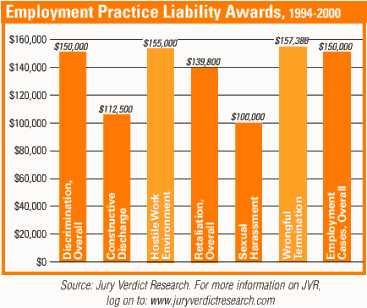It is often said that every situation has a light at the end of the tunnel, but the employment practices liability scene may have to squint just a little harder to see those rays of hope while higher prices, more courtroom time, and stricter underwriting maintain their stranglehold on the EPLI market. According to Fred Fisher, president of Los Angeles-based E.L.M. Brokers, “While I can’t lump together all lines of business, there is certainly a trend to get increases in premium ranging from 15 to 25 percent, sometimes higher than that. Deductibles are being raised, and in select areas of business, it has gotten to be a very difficult market. Those who are not members of large agent associations are having a very difficult time. Markets have increased their threshold for premium volume and revenue. One market withdrew from California because they had too much business here and they needed to even their book out with non-California accounts. Wholesalers are having a difficult time, as are MGAs. This has a double whammy, because who is going to be around to distribute the product?” Fisher added that one and two-man lawyers is a difficult market. “If there are three or four attorneys, they’re easier to do. Most of the carriers coming in are looking for larger accounts.”
Coverage more important than ever
Carrie Brodzinski, vice president and product manager of EPLI for Travelers noted, “Coverage has matured and become a lot more standard. We’re seeing rates and retentions going up. I don’t see any indications that it is slowing down or changing.”
While some companies may think a lawsuit can never happen to them, Brodzinski said that train of thought can lead to a major loss of income quickly.
“Some small employers feel like that this is a big city issue—that they don’t have to worry about it,” Brodzinski commented. “We have claims examples by regions of the country, things that can demonstrate that not only is it possible or likely to happen to you, if it does, the numbers are significant enough that if you’re a smaller employer, it is a way bigger event than for a larger one. Discrimination and sexual harassment are still the top two.” Brodzinski added that age discrimination claims are on the rise.
Jonathan Brown, director of Special Risk Division—International at Burns & Wilcox noted, “From what I hear, the American Disabilities Act is one of the faster growing areas of litigation, but harassment and wrongful termination are still there.” When asked if age discrimination cases are on the rise, Brown said, “You would expect that with the baby boomer generation getting older and its expectations of employment.”
Brown expects premium increases to continue. “This is still an evolving area of insurance,” he said. “Law firms discover that they can successfully sue in this area, (but) there are still areas of the country where it is not really the gold mine it is for others. Realistically, we can expect pricing and deductibles to continue rising. The one thing we haven’t really seen is terms shrinking. There hasn’t been much in the way of new exclusions coming in that I’ve seen. There has been some refinement of coverage, but if trends continue, you’ll see further people exiting the market and it getting even harder in the next 12 to 15 months unless the rates currently being charged prove to be very profitable. My gut feeling is that will not be the case.”

Dale Diamond, EPLI program manager for Illinois-based Shand Morahan & Co., a subsidiary of Markel Corporation that writes for smaller employers, stressed the importance of EPLI coverage for smaller firms. “EPLI has to be sold to small business owners,” he said. “Many small business owners will not ask for it. EPLI is a coverage that small business owners must have, especially in this economy.”
When it comes to a small business owner’s decision whether or not to purchase EPLI, Diamond said costs are a concern since all insurance premiums are rising. “Agents really have to sit down and explain the need for EPLI coverage. The small business owner may need E&O to fulfill an obligation to a client. In addition, most small business owners would not consider not purchasing general liability coverage. They do not consider EPLI coverage a high priority. However, that business owner is more likely to be sued by his or her employee than a customer.
“In addition,” he continued, “small business owners should remember that even cases where damages appear limited are a threat to their business assets. In certain instances the plaintiff’s lawyer will be able to recover his or her legal fees. There are a whole lot more plaintiff’s lawyers who used to shy away from this business who will now take these cases.
“Retail agents have to worry about their own potential for an E&O claim. If a business owner suffers an uncovered loss due to an employment claim, he or she is going to question his or her agent. The agent must explain that even the most careful business can be the victim of an employment practices claim, especially in these difficult economic times. If a small employer needs to cut the insurance budget, (EPLI is) not the area to cut. From what I’ve heard in the marketplace, it is getting difficult to find coverage for the very largest employers. However, the EPLI market is still competitive for smaller employers.”
Meeting a client’s needs is also very important, as coverage requirements will vary from business to business.
“Retail agents should also be careful to make sure the EPLI limits are adequate for their clients needs,” Diamond said. “Many employers have EPLI coverage as an add-on to their GL coverage. However, the limit for this coverage may be very low. Given the cost to defend an EPLI case, that low limit does not provide asset protection for the employer. Unless advised, an employer could mistakenly believe that he or she is adequately covered for EPLI. To be adequately covered, a stand-alone policy may be necessary. In addition, agents should look for ‘all risk’ coverage as opposed to a ‘named perils’ form that limits the type of wrongful employment practices covered. Finally, the agent should choose a carrier which provides comprehensive loss prevention services with the policy.”
Skyrocketing legal fees
According to Don Gwizdalski, executive vice president, branch manager of California-based Dodge, Warren & Peters, “There is clearly a differentiation between the public companies and the private. What we’re seeing in the private companies is a pretty wide variety of offerings in terms that are changing but not dramatically changing when compared to the public companies. The public companies are experiencing a dramatic change in limits, deductibles, co-insurance. The well-publicized collapses of some of the Fortune 500 companies—the Enrons of the world, have caused the marketplace to take a second look at how they’re underwriting that business. They’re certainly asking a lot more questions. On the private company placement, the pain hasn’t been as deep in the market place, so they’re benefiting from that.
“Carriers have been forthright in saying that this marketplace is likely to continue for the next 12 to 24 months … prepare your insureds and sales team for this type of action. One of the keys for agents is to keep your clients informed so that this is not something the client is hearing for the first time at renewal time. The woes of the property casualty industry, the financial products, the D&O and the EPL are very well publicized.”
Gwizdalski pointed out that legal fees have hit some clients right between the eyes.
“One example is a wrongful termination case where the legal fees were 12 times what the actual judgment was,” Gwizdalski said. “The judgment was for $5,000, but the legal fees were $60,000. As I discussed with our client, there is something really wrong with the system where the attorneys cost us $60,000 in defense costs for a $5,000 award.” And according to Brown, “The one thing you may see I suppose and it would be sensible, but I’m not sure it will happen, would be an increase in divorce between the non-profit D&O people and the EPLI people. There is an awful lot of EPLI written relatively cheaply inside non-profit D&O policies that is costing the non-profit D&O people a lot of money. I think it is time they started underwriting to EPLI disciplines rather than the more traditional non-profit D&O discipline.”
David Price, executive vice president and chief underwriting officer for Burns & Wilcox, added, “Sooner or later, some form of tort reform is going to be necessary because there will be too many losses, not enough premium and not enough carriers.”
To comment on this story, email: dthomas@insurancejournal.com.
Was this article valuable?
Here are more articles you may enjoy.


 Farmers Adjusters Cry Foul Over Workloads, Claims Handling in Letter to Regulators
Farmers Adjusters Cry Foul Over Workloads, Claims Handling in Letter to Regulators  Home Insurance at $10,000 a Year Shows California Buyers’ Pain
Home Insurance at $10,000 a Year Shows California Buyers’ Pain  ‘Extremely Dangerous’ Hurricane Beryl Takes Aim at Caribbean
‘Extremely Dangerous’ Hurricane Beryl Takes Aim at Caribbean  US Home Insurance Still Priced Too Low for Climate Risk, Says Swiss Re Chair
US Home Insurance Still Priced Too Low for Climate Risk, Says Swiss Re Chair 


